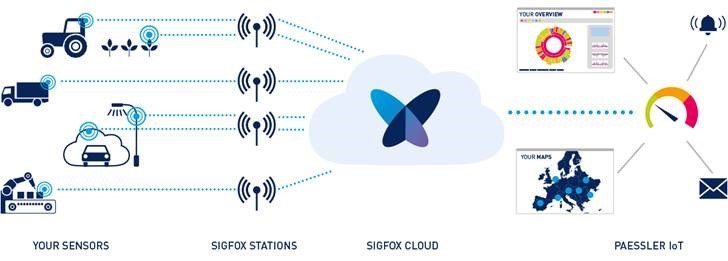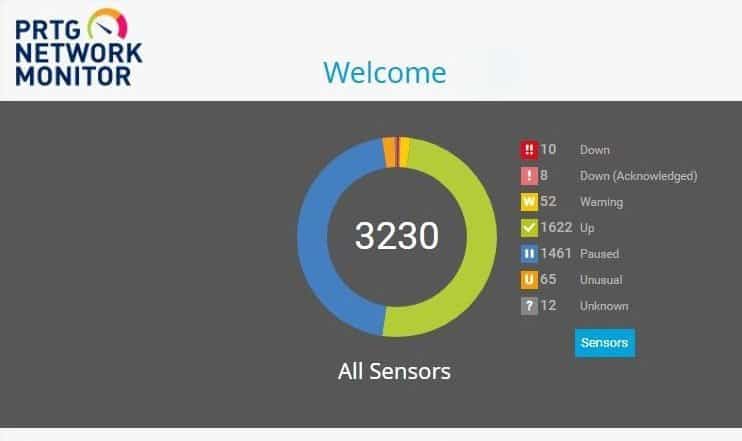Paessler currently focuses mainly on the IT infrastructure, on monitoring servers and networks. As soon as something goes wrong, their monitoring tool, PRTG, alerts the system and network administrators. This clear focus on IT is changing. Although monitoring the IT infrastructure remains important, the company also has great ambitions to monitor the Internet of Things. For now, the focus is on healthcare, cloud sensors and sensors from partner Sigfox. We talked about it with Wilco Ravestein, Channel Sales Manager at Paessler AG.
Most IT professionals will be familiar with Paessler’s PRTG tool for monitoring the IT infrastructure. The intention is that the tool will work mainly for administrators, not the other way around. In the end, PRTG distinguishes itself with very clear and simple monitoring, which can also be visualized if necessary. For example, if a switch goes offline, PRTG clarifies that the switch is the problem and not one of the 20 servers behind it.
With PRTG, Paessler no longer only monitors IT, but also IoT
Paessler is going to spread its wings and also monitor other things. The focus is no longer purely on the IT infrastructure. To start with, one looks at the Internet of Things (IoT). To take steps in this direction, a collaboration with Sigfox is happening, a company that develops network and sensor technology so that IoT sensors can communicate with the Sigfox Cloud via an LPWAN network. LPWAN stands for low power wide area network. Sigfox uses its own technology for this. Competitors in this area are LoRa, NB-IoT and LTE-M. These are networks with a very small frequency space and on which very small amounts of data can be communicated at very low costs. In addition, the company also has many partners who build IoT sensors based on the Sigfox LPWAN network.
For example, Sigfox has sensors that can measure the temperature, the humidity of the ground, how much rain falls or has fallen, sensors that measure distances, or that measure how full storage tanks are. Here, we are talking about sensors that are mainly used outdoors. There are also sensors that are more useful indoors. Think of smoke detectors, the use of an AED, how often an office chair is occupied, and so on. Sigfox really produces hundreds of sensors that communicate with the Sigfox Cloud via the LPWAN network.

The LPWAN network’s base stations are connected to the Internet. The values transmitted by the sensors are stored centrally in the Sigfox Cloud so that customers can consult them. Or, so that customers can have a tool such as PRTG monitor the data. PRTG does not communicate directly with all sensors, but simply with the Sigfox Cloud to retrieve and analyse the sensor data. If you have all data from the sensors and continue to read them continuously, you can almost take action in real-time.
National Computer Museum in the United Kingdom
Ravestein mentioned the National Computer Museum as an example. In this museum, you can find old but still working computers. However, the intention is that they will continue to work, as spare parts are scarce.
Every computer in the museum is equipped with sensors to measure temperature, humidity and even possible vibrations. If PRTG finds deviations in the data that cause the temperature to be too high or too low, a message can be sent to the administrator. The manager can then examine the computer or give it maintenance in order to extend its lifespan. If, for example, a cooler fan breaks down, they want to know before the chips really burn out. Such a cooler can often be replaced, but a chip cannot.
The museum also has sensors that measure how many people there are in each room. This information is used to use screens and lighting to indicate how busy it is in each room. This way, people know where it is quietest in the museum before you visit the room. The goal behind this is that people with a disability, who are not good at coping with crowds, are also welcome in the museum and can avoid possible busy places. But also for visitors who don’t want to queue up to see something, this is handy. They can then first visit the quieter parts of the museum.
Another example which Ravestein talked about is that of shrimp farmers. They also make grateful use of sensors, by measuring the quality and temperature of the water in which the shrimp are cultivated. The values of the water (acidity) are of enormous importance. Previously, growers had to take samples themselves in order to analyse the water manually. Now they can read this with a computer and take immediate action.
Paessler chooses focus areas
These examples show the previously mentioned focus on IoT, while Ravestein uses them to visualize forms of cloud sensors as well. PRTG retrieves the IoT sensor data from the cloud and then analyses it. However, there are also plenty of IoT devices with which PRTG will communicate directly in the future. One could think of a factory where a production machine or a conveyor belt is fitted with sensors to detect possible problems at an early stage. PRTG may communicate with this directly.
However, in the future, many IoT devices will communicate with a cloud environment or an edge computer on location to which sensors are connected. PRTG will also communicate with this. In the future, cloud sensors may, therefore, contain all kinds of data.
When we talk about Paessler’s focus area and the cloud sensors they mention in it, we should think more about cloud environments with servers, containers and applications. PRTG is already very capable of monitoring your on-premise environment, but the cloud must also be easy to monitor. In theory, this is the same solution at a different location. The fact that Paessler wants to play a greater role in this is not a strange choice.
Finally, there is healthcare, in which Paessler sees many developments. In healthcare, everything has to be done faster, cheaper and more efficiently. Innovation is playing an increasingly important role in this. If, for example, nurses and doctors can make notes directly to the patient on a handheld device, this will save a considerable amount of time. All the medical equipment used today is also becoming smarter and smarter. This equipment is often already connected to the internet and equipped with sensors. These specific sensors, such as Dicom and HL7, are also supported by PRTG. This allows the tool to see if the device is working properly and how often it is used. Medical scanners or analysis equipment must always be available. If not available, patients cannot be helped. By reading, monitoring and analysing these sensors, maintenance can be carried out on time, and the availability of the equipment can be improved. Paessler wants to focus on this.
There will undoubtedly be more sectors after that. For now, Paessler mainly wants to expand the market. During the interview, we noticed that a number of areas are now being chosen, but that the company certainly has the ambition to become active in more sectors. In this way, they also see smart cities as a great opportunity. Steps have even been taken in this market by measuring and monitoring the temperature and air quality in Singapore. When we talked to Ravestein about this, however, he did not mention it as one of the main focus areas. In the meantime, we have learned that Paessler is working on a smart city project in Belgium, so the urge for monitoring in more sectors is certainly there.
